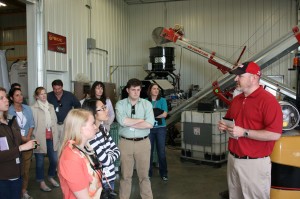2013 Asmark Retailers LIVE! Tour: 5 Takeaways

RANDT’s Jason McCardle (right) tells the Asmark Institute tour group how the implementation of Bayer’s On Demand seed treatment system has helped drive efficiency at the Lexington, IL, retailer.
Two weeks after the West Fertilizer tragedy, a group of 26 ag-industry association folks set out for a week of touring retail locations and interacting with industry members upon whom’s behalf many of them work on a daily basis. Comprised mainly of young employees from The Fertilizer Institute (TFI), Agricultural Retailers Association (ARA), CropLife America (CLA) and gracious host the Asmark Institute, the group received an up-close-and-personal schooling on some of the many challenges facing the industry today.
Here are five of the many takeaways from that valuable week:
1. An Ammonium Nitrate Battle Is Brewing: Ammonium nitrate (AN), that now-naughty word, was on the tip of everybody’s tongue throughout the week after it was learned that the fertilizer was found to be the cause of the two concussive explosions that shook West.
When it came to AN, of the 25 retail locations toured the group met three types: 1) those that strictly do not sell AN; 2) those that once sold AN but have since stopped; and 3) those that still vend 34-0-0. Agri-Gro Fertilizer, Hartford, KY, co-owner Scott Beddow, whose relatively small retail outlet lies conspicuously adjacent to a residential neighborhood, belongs to the second group. “We quit doing ammonium nitrate a couple of years after I came on (as manager),” he says. “We’ve got quite a bit of fuel on premises, so we could have potentially had an explosive situation pretty easily here.”
Ceres Solutions, Vincennes, IN, also fits into that second group. “We used to do AN, but after the Oklahoma City bombing we decided to move away from it,” says Dan Weber, vice president agronomy. “We switched to straight urea, and that upset some of our farmers, but we’ll go ahead and tell customers to use something else and risk losing those customers if it’s something we believe in strongly enough.”
Further south at Montgomery Farmer’s Cooperative, Smyrna, TN, a branch of Tennessee Farmer’s Cooperative, manager Chris Schmidt oversees a highly diversified operation (65% of sales in agronomy, 35% in consumer goods; $20 million annual sales) that also happens to sell AN in a high traffic area of town. Schmidt says the retailer stopped selling bagged AN in 2010, and the majority of the product now goes out in a blend. “We’ve never had any issues with the product,” he says. “We’re extremely careful and we make sure we stay on top of all the regulations.”
Schmidt would be remiss to overlook the growing sentiment, both outside and, to a smaller scale within the ag community itself, that wants to see the product done away with completely. “It’s a necessity,” he says in response. “Sure they’ve got other forms of nitrate, but AN is one that gives you good growth and is relatively safe compared to what some people may think.
“It’s essential for row crop production in this area of the country,” he continues. “Tobacco, wheat, rice and corn – these crops have got to have something to get them to grain stage.”
2. Proximity To Town Not The End All Be All: If you happen to peruse the comments section of virtually any article on the West tragedy (do so at your intelligence’s own risk), you’re sure to find some Monday Morning Quarterbacks valiantly taking the officials in West, TX, to task over “just why the West Fertilizer Co. was located so close to residential neighborhoods and schools.” However, as attendees found out, where a facility is located in proximity to municipal development isn’t always within the retailer’s control, and it’s not always a negative if that facility is near town.
“We were here way before the city ever was,” says Montgomery Farmers Cooperative’s Schmidt. “Now the city is right here in our backyard and any little hiccup that happens here everybody is going to know about it.”
In order to avoid those hiccups, the facility that Schmidt manages deploys a gauntlet of safety precautions, including eight-foot high perimeter fencing, motion detectors and cameras, and they also enjoy a healthy police patrol presence, one of the positives of being so close to town, according to Schmidt.
Meanwhile, up in Tolono, IL, at United Prairie, the group viewed a retail outfit that outgrew its original location smack dab in the middle of town, later building a much larger facility on a piece of property far away from any residential development. The city location now houses the branch’s administrative offices and some equipment storage, while all anhydrous ammonia and other hazardous materials are stored out at the new location.
3. Emergency Response Resources Already In Place: The Monday Morning Quarterbacks are also vehemently questioning the training and actions of the West emergency responders that tried to contain the fire prior to the two devastating explosions. And while it’s yet to be seen whether they have a leg to stand on in that regard (as of press time the cause of the fire is still unknown), the ag industry as a whole should not be on the hook for the actions and training (or lack thereof) of those emergency responders.
As the group witnessed throughout three scheduled stop offs at Asmark Institute facilities, the tools are readily available for any retailer that wishes to take dealership safety and security seriously. Namely, Asmark’s “Emergency Response To Ag Incidents Class”, taught at its Nashville, TN-area office by the engaging Bill Basham and his son Billy. The only class of its kind in the U.S., the course consists of four, eight-hour days of intense, hands-on training, after which participants take both a written examination and work through five simulated spill scenarios in teams, upon which they are evaluated.
“In my opinion, this is the best service Asmark has offered in its 24 years,” says Basham, a former Marine with a background in explosives whose energetic classroom demeanor ensures the class isn’t your typical yawn-inducing safety course. “What happens in the first three minutes of an emergency response determines whether you’ve got a $500 spill or a $1.3 million spill.”
Anhydrous ammonia safety and handling, as well as grain bin extraction training are also offered by Asmark, as are a plethora of other safety and security resources for ag retailers. Take advantage, folks, take advantage.
4. Regulatory Overload A Daunting Challenge: During the sessions at the Asmark Institute branches, participants got an inside peak at the overwhelming regulatory burdens ag retailers face in order to earn a living. Asmark president Allen Summers exposed the group to everything from compliance-based risk management practices to the thin grey line that differentiates an implement of husbandry (vehicle dedicated to crop production service) from a non-commercial vehicle and the requirements that go hand-in-hand with operating an implement of husbandry.
With lawmakers already breathing fire and brimstone for more regulation on the industry as a whole, perhaps what the industry needs isn’t more rules but better enforcement of the existing rules when one bad actor reveals itself.
5. Allstate Customers Ain’t The Only Ones In Good Hands: After five days of learning and discussing virtually every facet of ag retail, upon parting ways this author couldn’t shake the impression that this industry has some impressive, dynamic young leaders ready to go to bat for ag retailers and their grower-customers on Capitol Hill.
While industry folks may talk a lot about how agriculture is aging and there is a generational gap in the industry, the sheer passion and amount of knowledge displayed by the relatively youthful delegations from ARA, CLA, TFI and the National Agricultural Aviators Association seem to point otherwise. If I were an ag retailer, these people are exactly the type of passionate and insightful, tuned-in professionals I would want watching my back in Washington.






